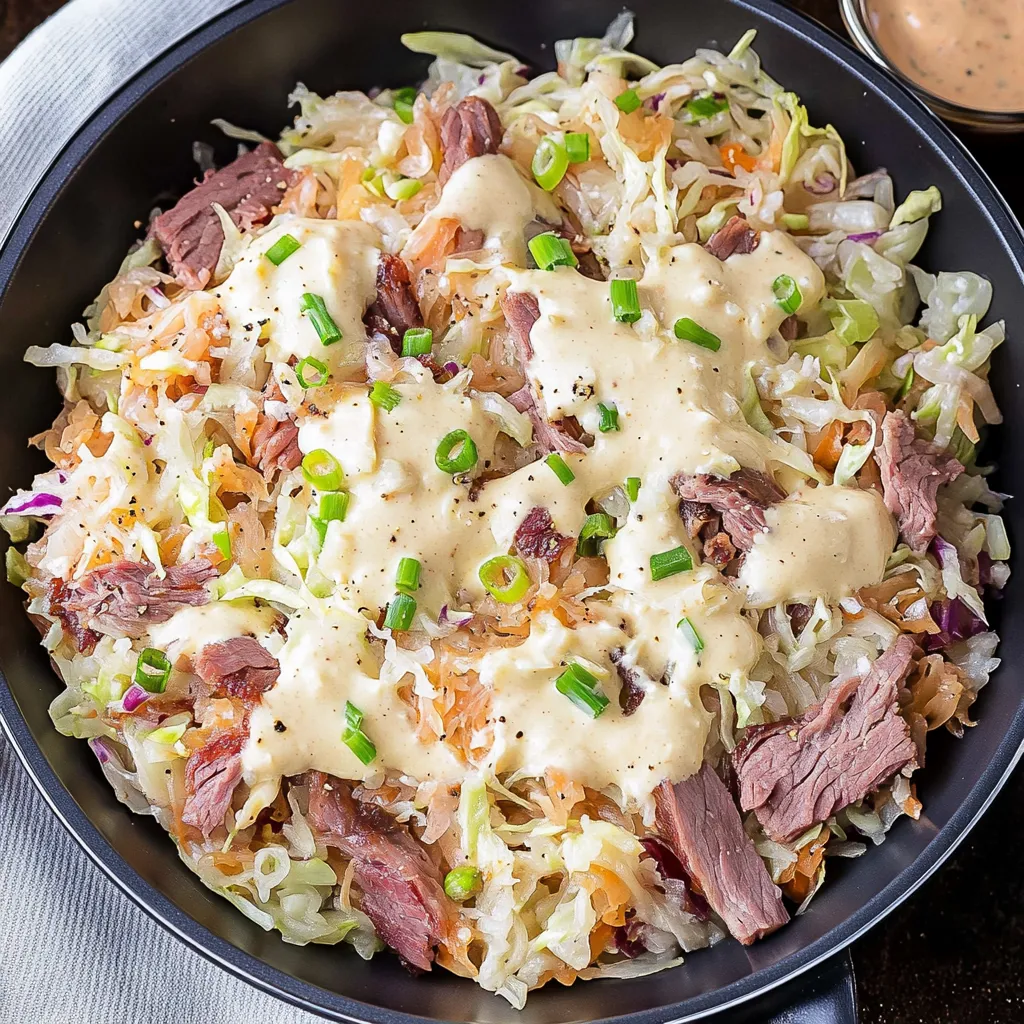 Pin it
Pin it
This brilliant Reuben in a bowl transforms the beloved deli sandwich into a satisfying, low-carb skillet meal that captures every iconic flavor of the classic while eliminating the bread and creating a healthier, one-pot dinner that's ready in under 30 minutes. The genius of this deconstructed approach lies in using tender cabbage as the perfect vehicle to absorb all the rich, savory flavors while maintaining the essential taste profile that makes a Reuben so irresistible - the tangy sauerkraut, smoky corned beef, melted Swiss cheese, and creamy Thousand Island dressing all come together in perfect harmony. Unlike heavy sandwich versions that can leave you feeling sluggish, this bowl format allows you to enjoy generous portions while keeping things keto-friendly and nutritious, proving that sometimes the best way to honor a classic dish is to reimagine it in a format that's even more delicious and satisfying than the original.
I developed this recipe when craving the complex flavors of a Reuben but wanting something lighter and more nutritious, and the breakthrough came when I realized that caraway seeds were the key to recreating that essential rye bread flavor that ties the whole dish together.
Essential Ingredients and Selection Tips
- Quality corned beef: Buy from the deli counter at medium thickness for easy cutting; look for brands with minimal additives and good marbling
- Fresh coleslaw mix: Choose bags with crisp cabbage and carrots; avoid wilted or yellowing vegetables that won't provide proper texture
- Good sauerkraut: Select brands with live cultures for better flavor and health benefits; drain thoroughly to prevent excess liquid in the dish
- Real Swiss cheese: Use authentic Swiss for the characteristic tangy, nutty flavor; avoid processed cheese products that won't melt properly
- Caraway seeds: Essential for authentic rye bread flavor; buy from stores with good turnover to ensure freshness and potency
- Quality Thousand Island ingredients: Make homemade for better flavor and to avoid unnecessary sugars and preservatives in commercial versions
The secret to perfect results is proper timing to keep cabbage crisp-tender and caraway seeds toasted for maximum flavor impact.
Detailed Step-by-Step Instructions
- Step 1: Prepare corned beef properly:
- Cut deli corned beef into bite-sized pieces, removing excess fat while leaving some for flavor and texture.
- Step 2: Sear meat for flavor:
- Heat oil in large skillet over medium heat and brown corned beef pieces for 3-4 minutes until crispy edges form.
- Step 3: Remove and drain:
- Transfer seared corned beef to paper towel-lined plate to remove excess fat while preserving crispy texture.
- Step 4: Build aromatic base:
- Add fresh oil to same skillet and sauté diced onion for 3 minutes until translucent and beginning to caramelize.
- Step 5: Toast spices:
- Add minced garlic and caraway seeds to onions, cooking 1 minute until fragrant and caraway seeds release their aroma.
- Step 6: Cook cabbage perfectly:
- Add coleslaw mix and cook 6 minutes, stirring frequently, until tender but still crisp with some bite remaining.
- Step 7: Combine main components:
- Return corned beef to skillet along with drained sauerkraut, salt, and pepper, mixing to distribute evenly.
- Step 8: Melt cheese beautifully:
- Top mixture with Swiss cheese, cover skillet, and cook just until cheese melts without overcooking cabbage.
- Step 9: Prepare homemade dressing:
- Whisk together mayonnaise, ketchup, sour cream, dill relish, and seasonings for fresh Thousand Island dressing.
- Step 10: Serve immediately:
- Divide mixture among bowls and drizzle generously with Thousand Island dressing while everything is hot and cheese is melty.
 Pin it
Pin it
The most important technique is timing the cabbage cooking to maintain proper texture and not overcooking after adding the cheese.
This Reuben bowl has become my favorite example of how classic comfort foods can be successfully adapted to healthier formats without losing their essential appeal.
Understanding Caraway Seed Impact and Flavor Chemistry
Caraway seeds contain carvone and limonene compounds that create the distinctive flavor associated with rye bread. Toasting these seeds briefly in the hot oil releases their volatile oils and intensifies their flavor, ensuring they distribute throughout the dish and provide that essential Reuben taste profile that makes this bowl feel authentic.
Cabbage Cooking Science and Texture Management
Proper cabbage cooking requires understanding how heat breaks down cell walls. The goal is to soften the cabbage enough to be tender while maintaining some structural integrity. Overcooking destroys the pleasant crunch and can create mushy, unappetizing texture that doesn't provide the satisfying contrast needed in this dish.
Sauerkraut Integration and Flavor Balance
Sauerkraut provides both tangy flavor and textural contrast, but its high moisture content requires proper draining to prevent the dish from becoming watery. The fermented cabbage also adds umami depth that complements the saltiness of the corned beef and richness of the cheese.
Cheese Melting Technique and Temperature Control
Swiss cheese melts best with gentle heat and minimal time to prevent breaking or becoming stringy. Covering the skillet creates steam that melts the cheese evenly while protecting the cabbage from overcooking during this final step.
Dressing Emulsion and Flavor Development
Homemade Thousand Island dressing creates a stable emulsion when properly mixed and benefits from resting time that allows flavors to meld. The combination of mayonnaise, ketchup, and pickle relish provides the sweet-tangy balance that defines Reuben sandwiches.
This Reuben in a bowl has taught me that the most successful dish adaptations focus on preserving the essential flavor combinations while improving the nutritional profile and practical aspects of preparation. Every time I make it, I'm reminded that comfort food doesn't have to be unhealthy or complicated when you understand which elements create the signature taste and which can be modified or eliminated without sacrificing the core experience, proving that some of the best "healthy" versions of classic dishes don't feel like compromises at all - they feel like improvements that let you enjoy beloved flavors more often and with less guilt.
Frequently Asked Questions
- → Can I use leftover corned beef instead of deli meat?
- Yes! Just shred your leftover corned beef into bite-sized pieces. It works perfectly and tastes even better.
- → How long does the Thousand Island dressing keep?
- Store it in the fridge for up to 2 weeks in a sealed container. It actually gets better after a day or two.
- → Can I make this recipe ahead of time?
- The bowl keeps for 4-5 days in the fridge. Just store the dressing separately and add it when ready to eat.
- → What can I substitute for caraway seeds?
- Try fennel seeds or just skip them entirely. The caraway gives that rye bread flavor, but it's still delicious without.
- → Is this recipe really low carb?
- Yes! With about 12 grams of carbs per serving, it's much lower than a regular Reuben sandwich with bread.
- → Can I freeze the leftovers?
- You can freeze the bowl mixture for up to 3 months, but the cabbage texture might change. Don't freeze the dressing.
